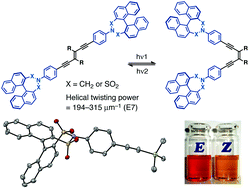1,2-Di(phenylethynyl)ethenes with axially chiral, 2,2′-bridged 1,1′-binaphthyl substituents: potent cholesteric liquid-crystal inducers†
Abstract
Axially chiral, 3,5-dihydro-4H-dinaphtho[2,1-c:1′,2′-e]azepine (

* Corresponding authors
a
Laboratorium für Organische Chemie, ETH Zürich, Hönggerberg, HCI, CH-8093 Zürich, Switzerland
E-mail:
diederich@org.chem.ethz.ch
Fax: +41 44-632-1109
b Alma Mater Studiorum–Università di Bologna, Dipartimento di Chimica Organica “A. Mangini”, Via San Giacomo 11, I-40126 Bologna, Italy
Axially chiral, 3,5-dihydro-4H-dinaphtho[2,1-c:1′,2′-e]azepine (

 Please wait while we load your content...
Something went wrong. Try again?
Please wait while we load your content...
Something went wrong. Try again?
Y. Wu, F. Ferroni, S. Pieraccini, W. B. Schweizer, B. B. Frank, G. P. Spada and F. Diederich, Org. Biomol. Chem., 2012, 10, 8016 DOI: 10.1039/C2OB25983D
To request permission to reproduce material from this article, please go to the Copyright Clearance Center request page.
If you are an author contributing to an RSC publication, you do not need to request permission provided correct acknowledgement is given.
If you are the author of this article, you do not need to request permission to reproduce figures and diagrams provided correct acknowledgement is given. If you want to reproduce the whole article in a third-party publication (excluding your thesis/dissertation for which permission is not required) please go to the Copyright Clearance Center request page.
Read more about how to correctly acknowledge RSC content.
 Fetching data from CrossRef.
Fetching data from CrossRef.
This may take some time to load.
Loading related content
